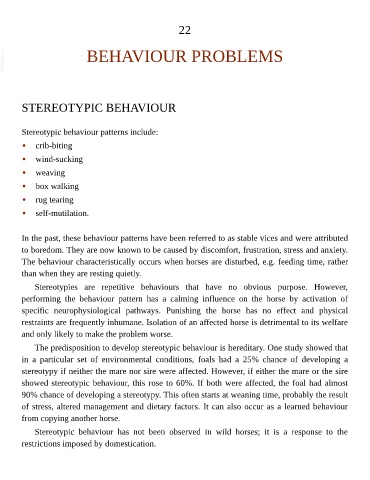Page 1015 - The Veterinary Care of the Horse
P. 1015
22
VetBooks.ir BEHAVIOUR PROBLEMS
STEREOTYPIC BEHAVIOUR
Stereotypic behaviour patterns include:
• crib-biting
• wind-sucking
• weaving
• box walking
• rug tearing
• self-mutilation.
In the past, these behaviour patterns have been referred to as stable vices and were attributed
to boredom. They are now known to be caused by discomfort, frustration, stress and anxiety.
The behaviour characteristically occurs when horses are disturbed, e.g. feeding time, rather
than when they are resting quietly.
Stereotypies are repetitive behaviours that have no obvious purpose. However,
performing the behaviour pattern has a calming influence on the horse by activation of
specific neurophysiological pathways. Punishing the horse has no effect and physical
restraints are frequently inhumane. Isolation of an affected horse is detrimental to its welfare
and only likely to make the problem worse.
The predisposition to develop stereotypic behaviour is hereditary. One study showed that
in a particular set of environmental conditions, foals had a 25% chance of developing a
stereotypy if neither the mare nor sire were affected. However, if either the mare or the sire
showed stereotypic behaviour, this rose to 60%. If both were affected, the foal had almost
90% chance of developing a stereotypy. This often starts at weaning time, probably the result
of stress, altered management and dietary factors. It can also occur as a learned behaviour
from copying another horse.
Stereotypic behaviour has not been observed in wild horses; it is a response to the
restrictions imposed by domestication.

